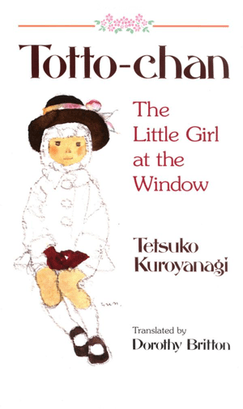Totto-Chan: The Little Girl at the Window facts for kids

First Asian edition cover (English)
|
|
| Author | Tetsuko Kuroyanagi |
|---|---|
| Original title | Madogiwa no Totto-chan |
| Translator | Dorothy Britton |
| Illustrator | Chihiro Iwasaki |
| Cover artist | Chihiro Iwasaki |
| Country | Japan |
| Language | Japanese |
| Genre | Children's literature, Autobiographical novel |
| Publisher | Kodansha Publishers Ltd. |
|
Publication date
|
1981 |
|
Published in English
|
1982 |
| Media type | Print (Paperback) |
| Pages | 232 |
| ISBN | 978-4-7700-2067-3 |
Totto-chan, the Little Girl at the Window is a famous book written by Japanese TV star and UNICEF Goodwill Ambassador Tetsuko Kuroyanagi. This book is a true story about her own childhood. It was first published in Japan in 1981 and quickly became a huge bestseller.
The story shares the special way Tetsuko Kuroyanagi was taught at Tomoe Gakuen. This was a unique Tokyo elementary school started by an educator named Sosaku Kobayashi during World War II. The Japanese title of the book, Madogiwa no Totto-chan, means "Totto-chan by the window." This phrase can also describe someone who has failed, but in the book, it shows Totto-chan's unique way of looking at the world.
Contents
Why Was Totto-chan Written?
Tetsuko Kuroyanagi decided to write Totto-chan after hearing that many children were not going to school. She wanted to share her own positive school experience. The book was first published as a series of articles in a Japanese magazine from 1979 to 1980.
Later, these articles were put together into a book. It sold over 5 million copies by the end of 1982. This made it the bestselling book in Japanese history at that time. An English version, translated by Dorothy Britton, came out in America in 1984. The book has been translated into many languages around the world.
What Is Totto-chan About?
The story begins when young Totto-chan is asked to leave her public school. Her mother realizes Totto-chan needs a school where she can be more free to express herself. So, her mother takes Totto-chan to meet Mr. Kobayashi, the headmaster of a new school called Tomoe Gakuen.
Totto-chan's New School Life
At Tomoe Gakuen, Totto-chan makes many friends and learns important lessons. The school has a lively and welcoming atmosphere. Mr. Kobayashi introduces new activities to keep the students interested. He truly understands children and helps them grow in their minds and bodies.
Mr. Kobayashi cares deeply for all children, including those with physical challenges. He believes every child is special. Totto-chan becomes best friends with a Christian boy who has polio. Another classmate grew up in America and cannot speak Japanese. The headmaster encourages the children to learn English from him. This was unusual because the government at the time did not want people using the "enemy's" language.
Life During Wartime
The children at Tomoe Gakuen live happy lives, mostly unaware of the big events happening in the world. World War II has started, but the school tries to keep things normal. Still, there are small signs that things are changing. For example, Totto-chan cannot buy her favorite caramel candies anymore. Also, it becomes harder for her mother to prepare a balanced lunch.
In one sad scene, a boy cries because his parents are taking him out of the school. Headmaster Kobayashi feels helpless and also sheds tears.
The School's End
One day, the school is bombed during the war. It is never rebuilt. Even so, the headmaster says he looks forward to building an even better school in the future. This event brings an end to Totto-chan's time as a student at Tomoe Gakuen.
How Totto-chan Is Used in Education
Starting in 1983, Totto-chan was used as a textbook for third-year elementary students in Japan. Parts of the book were also used in at least one American school in 1993.
However, in one area of Japan called Aichi Prefecture, the book was not allowed in school libraries for some time. This was because it was written by a television personality, which some people thought was not a serious job. Other books about liberalism and feminism were also banned there around the same time.
Other Works Inspired by Totto-chan
Tetsuko Kuroyanagi started the Totto-chan Foundation. This group trains deaf actors to perform live theater for the deaf community.
In 1999, Kuroyanagi wrote another book called Totto-Chan's Children: A Goodwill Journey to the Children of the World. This book is about her travels around the world as a UNICEF Goodwill Ambassador, helping children in need.
A Japanese composer named Akihiro Komori also created an orchestral music piece inspired by the book.
Images for kids


